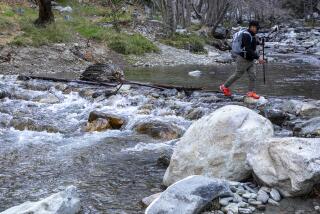Bringing Life to Hills : Environment: State will seed open space destroyed in Laguna fire despite opposition from environmentalists.
LAGUNA BEACH — Casting aside the objections of some local environmentalists, California Department of Forestry officials announced Wednesday that the state will begin aerial seeding of 10,000 acres of open space destroyed during the Laguna Beach fire.
Preliminary plans call for dropping native sage scrub seed on a largely uninhabited area under state control, but recommendations do not address what action to take in populated areas where fire officials have warned of a strong danger of mudslides in the event of heavy rains.
“We’re definitely going to seed,” Department of Forestry spokesman Doug Forrest said after a marathon 3 1/2-hour, closed-door meeting of local, county, state and federal agencies. “We’re taking steps right now to find out what seed might be available.”
According to Forrest, helicopter drops will begin as soon as officials can obtain at least 30,000 pounds of seed--most likely within the next two weeks. He said the agency has drawn up a working list of 14 species of native sage scrub that could be used in the effort.
Environmentalists vehemently oppose reseeding to help prevent soil erosion, maintaining that nature should be allowed to take its course.
“Our ecologists feel that it is not a good idea and there are a number of studies that show that seeding does not work in terms of flood control,” said Michael Eaton, a ranger at Crystal Cove State Park, one of the areas targeted for reseeding.
State officials have offered to seed within Laguna Beach itself, but city officials have not approved the action and a decision is unlikely before Friday, according to Forrest.
“The city of Laguna Beach will be responsible for the areas within the city limits,” he said. “If they would like us to seed we will, but they are responsible for deciding what rehabilitation efforts that they want there.”
Eaton, who attended the meeting, said he and others present were stunned because they had agreed not to recommend seeding.
Forrest had returned to the meeting room later and announced that he had received a telephone call from Sacramento indicating that the state intended to forge ahead despite the agreement, Eaton said.
The Crystal Cove State Park is targeted for reseeding in an area that runs from Laguna Canyon Road in a northwesterly direction.
For environmentalist Elisabeth Brown, reseeding goes against the very raison d’etre of the park.
“The mission of Crystal Cove State Park is to preserve some of California’s natural heritage. You don’t do that by blitzing it with grass,” said Brown.
There are two sides in the ongoing debate.
On the one, Eaton said, is the Department of Forestry, the city of Laguna Beach and some members of the County Board of Supervisors who favor reseeding.
But other ecologists and agency officials oppose the move on several grounds. First, they say, the seedlings could be washed away if a downpour occurs before the seeds have a chance to take root. In that case, the seeds could enter drainage areas, sprout and cause further problems.
The issue is particularly critical, participants said, in light of the fast-approaching rainy season when rainwater is likely to run off the now-barren hillsides, causing potentially destructive flooding and mudslides.
But many environmentalists argue that flooding is inevitable.
“In a lot of cases, people are demanding action, but you have to ask yourself is there really anything that can be done,” said Tom Scott, a natural resources specialist at the UC Riverside.
Reseeding Laguna Canyon
A variety of methods can be used to rejuvenate the growth of grasses across the burned bluffs and canyons of Laguna. How hillsides will be reseeded and what native flora will look like over the next five years:
* Aerial reseeding: Helicopters or aircraft tankers drop grass seed onto wilderness areas.
Advantage: Works best in open spaces.
* Hydro seeding: A soup of grass seed, mulch and water is sprayed through a hose from a tanker truck.
Advantage: Best used around housing.
* Hemp: Netting holds soil in place while grass sprouts and takes hold.
Advantage: Best for hillsides.
Sequence of Regrowth
Area conservationists predict that, within a few months to a year, native grasses will once again cover burned hillsides. New growth will sprout from unburned roots of native bushes and trees.
One year after fire
* Native grasses--generally fescue--and buckwheat flourish.
* Wildflowers and small cacti dot the landscape.
* Clusters of coastal sage scrub pop up along hillsides.
Three years after fire
* A highly flammable shrub, chamise, now up to 10 feet tall.
* Native shrubs, including lemonade berry, sage scrub and laurel sumac, cover canyons and bluff tops.
* Trees sprout in canyons and on bluff tops.
Five years after fire
* Dense green chamise, up to 15 feet tall, covers hillsides.
* Grasses, flowers and shrubs are fully established in canyons.
* Trees, including willows, eucalyptus and sycamores, are nearing full height.
Source: USDA Soil Conservation
Researched by APRIL JACKSON / Los Angeles Times
More to Read
Sign up for Essential California
The most important California stories and recommendations in your inbox every morning.
You may occasionally receive promotional content from the Los Angeles Times.










